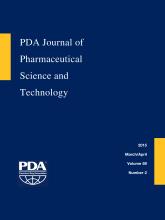Review ArticleReview
Adapting to Biology: Maintaining Container–Closure System Compatibility with the Therapeutic Biologic Revolution
Dominick Degrazio
PDA Journal of Pharmaceutical Science and Technology March 2015, 69 (2) 219-235; DOI: https://doi.org/10.5731/pdajpst.2015.01032
Dominick Degrazio
West Pharmaceutical Services, Exton, PA, USA

References
- 1.↵
- Ukraintseva S.V.,
- Yashin A. I.
- 2.↵
- Leader B.,
- Baca Q. J.,
- Golan D. E.
- 3.↵
- van Beers M. M.,
- Bardor M.
- 4.↵
- 5.↵
U.S. Food and Drug Administration, Center for Biologics Evaluation and Research. Guidance for Industry—Early clinical trials with live biotherapeutic products: Chemistry, manufacturing, and control information, 2012.
- 6.↵
- 7.↵
U.S. Food and Drug Administration, Center for Drug Evaluation and Research. Guidance for industry—Immunogenicity assessment for therapeutic protein products, 1999.
- 8.↵
U.S. Food and Drug Administration, Center for Drug Evaluation and Research. Guidance for industry—Container closure systems for packaging human drugs and biologics, 1999.
- 9.↵
- Baumann A.
- 10.↵
- Kuriyan J.,
- Konforti B.,
- Wemmer D.
- 11.↵
- 12.↵
- Petsko G. A.,
- Ringe D.
- 13.↵
- Zhou S.,
- Lewis L.,
- Singh S. K.
- 14.↵
- Gummadi S. N.
- 15.↵
- Harano Y.
- 16.↵
- 17.↵
- Chi E. Y.,
- Krishnan S.,
- Kendrick B. S.,
- Chang B. S.,
- Carpenter J. F.,
- Randolph T. W.
- 18.↵
- Change B.S.,
- Yeung B.
- 19.↵
- Patel J.,
- Kothari R.,
- Tunga R.,
- Ritter N. M.,
- Tunga B. S.
- 20.↵
- Powell M. F.
- 21.↵
- Li S.,
- Nguyen T. H.,
- Schoneich C.,
- Borchardt R. T.
- 22.↵
- Chirmule N.,
- Jawa V.,
- Meibohm B.
- 23.↵
- Jiskoot W.,
- Randolph T. W.,
- Volkin D. B.,
- Middaugh C. R.,
- Schoneich C.,
- Winter G.,
- Friess W.,
- Crommelin D. J.,
- Carpenter J. F.
- 24.↵
- Brennan T.V.,
- Clarke S.
- 25.↵
- 26.↵
- Xie M.,
- Schowen R. L.
- 27.↵
- Robinson N. E.
- 28.↵
- Miyata T.
- Monnier V. M.,
- Nemet I.,
- Sell D. R.,
- Weiss M. F.
- 29.↵
- Shacter E.
- 30.↵
- Li S.,
- Schöneich C.,
- Borchardt R. T.
- 31.↵
- Stadtman E. R.
- 32.↵
- Gsponer J.,
- Vendruscolo M.
- 33.↵
- 34.↵
- Borgia M. B.,
- Nickson A. A.,
- Clarke J.,
- Hounslow M. J.
- 35.↵
- Stranks S.,
- Ecroyd H.,
- Van Slutyer S.,
- Waters E. J.,
- Carver J. A.,
- von Smekal L.
- 36.↵
- Morris A. M.,
- Watzky M. A.,
- Finke R. G.
- 37.↵
- 38.↵
- 39.↵
- Rousseau F.,
- Schymkowitz J.,
- Serrano L.
- 40.↵
- Linding R.,
- Schymkowitz J.,
- Rousseau F.,
- Diella F.,
- Serrano L.
- 41.↵
- Baldwin R. L.,
- Frieden C.,
- Rose G. D.
- 42.↵
- Roseberg A. S.
- 43.↵
- Kayser O.,
- Muller R. H.
- Meibohm B.,
- Derendorf H.
- 44.↵
- Crommelin D. J. A.,
- Sindelar R. D.,
- Meibohm B.
- Meibohm B.,
- Braeckman R. A.
- 45.↵
- Schellekens H.
- 46.↵
- 47.↵
- Tang L.,
- Persky A. M.,
- Hochhaus G.,
- Meibohm B.
- 48.↵
- 49.↵
- Wang W.,
- Wang E. Q.,
- Balthasar J. P.
- 50.↵
- Haynes C. A.,
- Norde W.
- 51.↵
- Brash J. L.,
- Wojciechowski P. W.
- Norde W.,
- Haynes C. A.
- 52.↵
- 53.↵
- 54.↵
- 55.↵
- Liu L.,
- Ammar D. A.,
- Ross L. A.,
- Mandava N.,
- Kahook M. Y.,
- Carpenter J. F.
- 56.↵
- Seidl A.,
- Hainzl O.,
- Richter M.,
- Fischer R.,
- Bohm S.,
- Deutel B.,
- Hartinger M.,
- Windisch J.,
- Casadevall N.,
- London G. M.,
- Macdougall I.
- 57.↵
- Greenwood N. N.,
- Earnshaw A.,
- Greenwood N.
- 58.↵
- Ball D. J.,
- Norwood D. L.,
- Stults C. L. M.,
- Nagao L. M.
- 59.↵
- Kehrer J. P.
- 60.↵
- Hawkins C. L.,
- Pattison D. I.,
- Davies M. J.
- 61.↵
- Liu D.,
- Nashed-Samuel Y.,
- Bondarenko P. V.,
- Brems D. N.,
- Ren D.
- 62.↵
- LoPachin R. M.,
- Barber D.,
- Gavin T.
- 63.↵
- Elfarra A. A.
- Elfarra A. A.,
- Krause R. J.
In This Issue
PDA Journal of Pharmaceutical Science and Technology
Vol. 69, Issue 2
March/April 2015
Adapting to Biology: Maintaining Container–Closure System Compatibility with the Therapeutic Biologic Revolution
Dominick Degrazio
PDA Journal of Pharmaceutical Science and Technology Mar 2015, 69 (2) 219-235; DOI: 10.5731/pdajpst.2015.01032
Jump to section
- Article
- Abstract
- Introduction
- Small Molecules vs Therapeutic Biologics
- Stability of Proteins
- Protein Instabilities
- Chemical Modifications
- Physical Instabilities
- Immunogenicity of Therapeutic Biologics
- Compatibility of Primary Parenteral Packaging Components with Biologics
- Conclusion
- List/Definition of Symbols
- Declaration
- Acknowledgements
- References
- Figures & Data
- References
- Info & Metrics
Related Articles
- No related articles found.
Cited By...
- No citing articles found.





